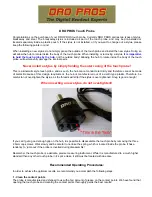
11
ERT_S series Ebbert Rivet Tools (HK1038
)
Rivet Tool Handle Function
The rivet tool handle contains the air valve mechanism which,
when actuated, initiates the rivet station cycle.
Figure 4A shows the valve components in the “at rest”
position. The steel ball is sealing air pressure within the red air
line chamber.
Figure 4B shows how the double Quad-rings function to
seal the forward section of the chamber when the trigger is
pressed, directing air pressure through the green air line back
to the Four-way Valve.
After prolonged use, the Quad-rings will wear down resulting
in a poor seal when the trigger is actuated. This can slow
down the cycle time of the tool due to the rivet tool operator
holding the trigger in a tighter position when setting the rivet.
It is easy to remedy the problem. Remove the trigger pin,
trigger, and valve plunger for Quad-ring replacement.
On models ERT1S and ERT2S, the handle is adjustable through
a 20-degree arc. This patented design allows relief to the wrist
when work heights are high or low to the operator’s normal
body position.
Each tool is provided with a 5/32” hex ball driver for the
handle adjustment. By loosening the socket head screw
located inside the handle, the handle can be moved into the
desired position and locked into that location with the hex ball
driver.
In some operations requiring excessive loads on the handle, it
is suggested that the clamp block be reversed, placing the flat
surface into contact with the handle for higher locking force.
NOTE: Make sure the trigger is square to the handle slot
and moves freely after tightening the clamp block.
1. Disconnect the rivet tool air-line from the Power Unit.
2. Attach Bleed Pump 300509 to the hydraulic hose on the rivet tool.
3. Remove the bleed screw from the tool.
4. Pump the bleed pump until no more bubbles appear out of the bleed port of the tool.
F
igures
4
a
&
4
b
Air Bleeding Instructions





































